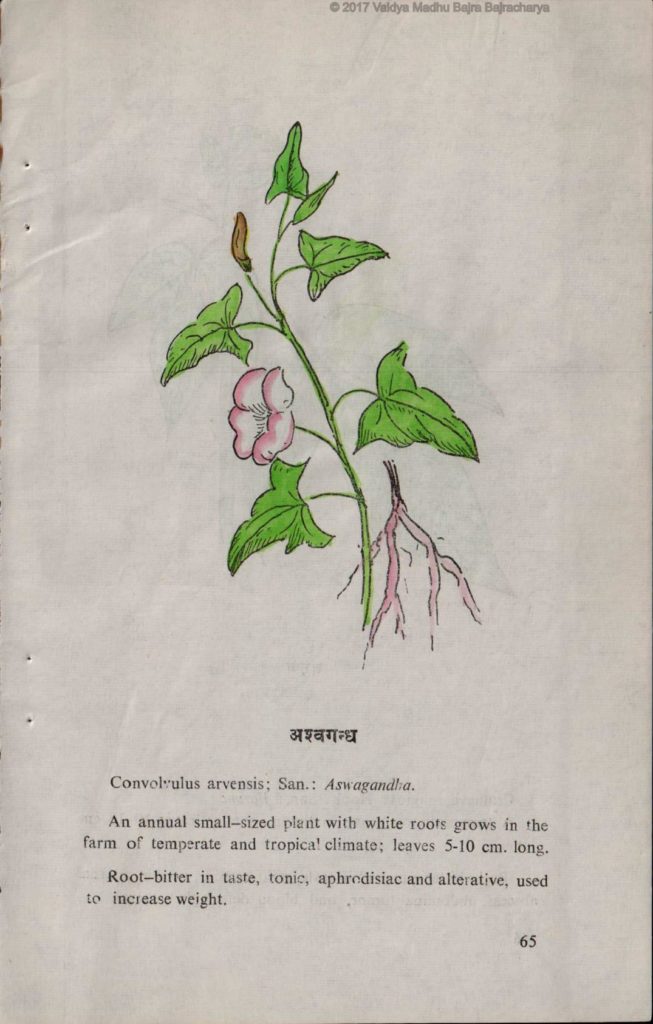Latin: Convolvulus spp., Withania somnifera
Sanskrit: Ashwagandha
WHAT IT DOES: Ashwagandha root is bitter in taste, warming in action, and a strong rasayana tonic for longevity. It calms and strengthens the nervous system (Vata); reduces stress; strengthens immunity and vitality; supports adrenal function; increases sexual energy; improves cognition and memory; nourishes thyroid.
RATING: Gold
SAFETY ISSUES: Not to be used during pregnancy. Do not use Withania somnifera with barbiturates due to potentiation effects. The Nepalese Convolvulus arvensis variety has no known safety issues (Todd FG et al., 1995).
STARTING DOSAGE:
• Dried powder: two grams two to three times per day
• 4:1 concentrated powder extract: one gram two to three times per day
• 1:5 tincture: 20-40 drops two to three times per day

There are two different plants known by the Sanskrit name ashwagandha. Both are effective. It is almost certain that the Himalayan mountain variety, a Convolvulus spp. plant found in Nepal, is the original one described in Sanskrit texts, and that Withania somnifera was discovered and used later by doctors in India, south of Nepal.
In our clinic we use both of these plants to strengthen the immunity and vital force of weakened patients showing signs of anxiety or nervousness. Ginseng root, commonly used as a tonic, would not be a good choice in such case due to its excitatory action.
The Convolvulus variety of ashwagandha root is a perennial bushy plant with white roots that is usually found in tropical areas. It commonly grows at the base of wheat, spiraling around the stems, and Dr. Mana and I located specimens within minutes when we searched wheat farms in Nepal.
The root is an aphrodisiac, and can be used to treat any nervous system disease. It is used to treat nervous exhaustion, poor memory, muscle weakness and impotence. If a person is very weak, the strength of ashwagandha root seems to penetrate into the core of one’s being.
Withania somnifera has now taken over the common name of ashwagandha root throughout the world. Also an excellent plant, it seems to impart overall energy to the system, with a marked calming effect. It is commonly called the ginseng of India.
The traditional way of preparing it for nerve diseases (Vataja) is to mix it into an approximate 50/50 ratio with ghee, and take one teaspoon two to three times per day. This tonic can be given to feeble children to increase their weight. It imparts a sense of well being and strength, as well as improved memory. In the interest of comparison, I have taken both forms of the herb. They are very similar in their calming effects, but the Nepalese variety has a much stronger aphrodisiac effect similar to that of Muira puama balsam.
Research highlights
• A true adaptogen, investigators have demonstrated ashwagandha root’s effectiveness in animal models against a wide variety of biological, physical and chemical stressors (Pandley et al., eds, 1996; Rege et al., 1999; Archana et al., 1999; Dhuley, 1998, Mishra et al., 2000).
• Pharmacological studies show it can prevent immunosuppression caused by exposure to strong chemical agents, and may be valuable in restoring immunity after exposure to or treatment with such drugs (Ziauddin M et al., 1996). It also provides protection against some side effects of chemotherapy (Pandley et al., eds, 1996) and to actually help cancer treatment.
• It has been found useful for male fertility, and to increase endurance in athletes.
• The alcohol extract of ashwagandha root has significant anti-inflammatory action in both acute and chronic types of inflammation, as demonstrated in rabbit, guinea pig, rat and frog animal models (Pandley et al., eds, 1996).
• Citing a total of 31 studies, the Indian Central Council for Research on Ayurveda and Siddha tells us that ashwaganda root exerts its most powerful pharmacological influence on the reproductive system, neuropharmacological disorders, cardiovascular system, respiratory system, bacteria, fungi, inflammation and gastric acidity (Pandley et al., eds, 1996).
• Some preliminary evidence points to a positive action on the thryoid gland.
